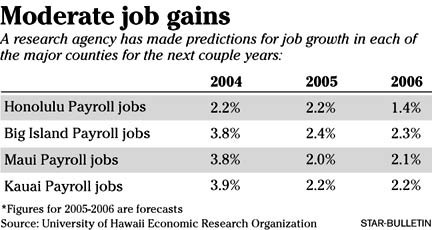Islands face limits
on future growth
An economic rebound is
tempered statewide by
the number of workers
and hotel rooms
Hawaii's economic growth is expected to continue through next year across the major islands. But a limited number of rooms in the hotel industry and a tight labor market likely will cause growth to slow next year, a team of University of Hawaii economists predicts.
In a forecast released yesterday, the UH Economic Research Organization predicts that visitor arrivals, total jobs and real personal income will increase in each of the major counties through 2005 and 2006. However, the economists also predict the growth will slow.
For example, Oahu saw a 9.4 percent increase in visitors last year, and forecasters expect arrivals to increase again this year by 6.3 percent. But in 2006, the university researchers predict the growth rate will drop to 2.1 percent.
Likewise, the number of jobs grew by 2.2 percent in 2004 and is expected to do the same this year. But the researchers predict the growth rate will drop to 1.4 percent next year.
Real personal income growth will follow the same pattern. In Honolulu, for example, personal income adjusted for inflation grew by 3.5 percent in 2004. But that growth is expected to slow to 2.8 percent this year and 2.3 percent in 2006.

"This is driven by our view that the labor force is not going to grow faster than a certain rate," Gangnes said. "And that constrains the growth of jobs, and that in turn constrains income growth."
Hawaii is enjoying its strongest economy since the early 1990s, driven largely by a real estate and construction boom coupled with growth in services sectors, such as restaurants and business services.
The state's unemployment rate of 2.7 percent reported for May is the lowest in 14 years. At the same time, the labor force has grown. Strong demand for workers in key industries has driven up wages in key industries.
The forecasters predict construction jobs to grow by 7.5 percent on Oahu, 4.7 percent on the Big Island and 4.2 percent on Maui and Kauai.
The problem, Gangnes said, is that increasing prices could lead to a cooling of this growth. With hotels already running occupancies in the 80 percent range on Oahu and no new rooms opening soon, Gangnes said, visitors might opt to stay away as fuller rooms push up rates.
Likewise, commercial developers and home builders might decide the cost of workers is simply too high to keep building at the current pace as the supply of skilled workers becomes increasingly tight, Gangnes said.
The result, he said, will be a "pattern of a slowing local economy but not a stagnating one."
Despite the predicted growth, the forecast envisions relatively small inflation. Gangnes said the inflation rate is expected to be 4 percent this year. However, he cautioned that it could turn out higher if housing costs continue to increase at current levels.
The UH Economic Research Organization bases its forecasts on statistical models developed by the group's economists, Gangnes said. Co-writing the forecast were Carl Bonham of UH and economist Leroy Laney.
E-mail to Business Desk
[News] [Business] [Features] [Sports] [Editorial] [Do It Electric!]
[Classified Ads] [Search] [Subscribe] [Info] [Letter to Editor]
[Feedback]
